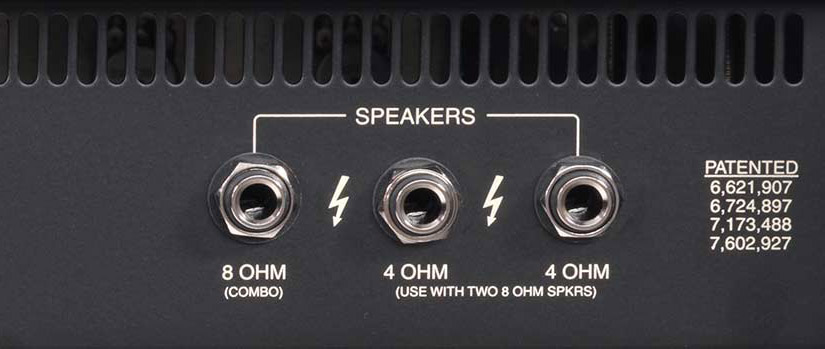Speaker cabinet impedance, and how to properly connect your cabinet to your amplifier is one of the least understood parts of guitar rigs, and can be one of the most important in getting the proper tone and performance from your amp (as well as not blowing stuff up!)

Here's some speaker cabinet and impedance basics:
- Cabinets have impedance, Amps don't. In short, the impedance is the measure of how much resistance a speaker (or in the case of a multiple speaker cabinet the cabinet as a whole) provides to the amp. The amp "pushes" the signal to the cabinet, and the higher the impedance, in effect the harder it is for the amp to push the signal.
- ALWAYS use Speaker cable to connect your amp safely to your cabinet, never Guitar (instrument) cable. This one seems simple, but is one of the biggest mistakes that is commonly made. There IS a big difference in the way speaker cables are made, they are designed to handle a powered signal and do not have shielding. Guitar cables are NOT designed to handle a powered signal, and do have shielding. Accidentally plugging in our guitar to your amp using a speaker cable won't hurt anything, but it will hum like crazy. Accidentally using guitar cable between your amp and cabinet not only results in really poor tone, but can physically damage your amp (like blowing your output transformer, OUCH)
[caption id="attachment_68" align="alignnone" width="286"] Guitar Cable[/caption]
[caption id="attachment_70" align="alignnone" width="300"]
Guitar Cable[/caption]
[caption id="attachment_70" align="alignnone" width="300"] Speaker Cable[/caption]
Speaker Cable[/caption]
3. To properly connect your amp to the cabinet, check the listed impedance on the back of your cabinet (usually 16, 8, or 4 ohms), and plug your speaker cable into the corresponding jack on your amp (on some amps there are multiple jack options, some amps have a pair of jacks and some type of adjustable dial or switch to match the impedance level)
4. When using two speaker cabinets, you almost always will be connecting them in parallel, either using the 2 output jacks on the amp, or using the speaker out/parallel jack on the back of the speaker cabinet. Running two cabinets in parallel drops your overall impedance, as essentially you make it twice as easy for the amp to push, as the signal has two places to go. If you are using two cabinets of matching impedance you effectively drop the impedance in half (see Ohm's law). If they are mismatched impedance you will drop the overall impedance down lower than the impedance of the lower of the 2 cabinets. For instance, if you use 2 16 ohm cabinets (like Marshall 4x12s) together in parallel you'll get an 8 ohm load. With a lot of Mesa cabinets, the individual cabinets are 8 ohm cabinets, and when you use 2 together you'll unplug from the 8 ohm jack and plug into the 2 4 ohm jacks.

5. For some amps, the tone will actually be different depending on the impedance, for others it will be largely the same. The difference will depend on the era of your amp, and what type of transformer it uses. Most modern amps use a tapping transformer, that allow it to get roughly the same performance at any of its listed impedance settings. Many vintage amps will be affected in their level of overall headroom and output based on the impedance of the cabinet. A higher impedance will make the amp work harder, causing less headroom and an earlier onset of power tube distortion.
6. NEVER go below the listed Minimum impedance setting for your amplifier. Most amps will have a minimum impedance listed somewhere on the back. For guitar amps it usually 4 ohms, though for some it is only 8. Most bass amps handle anything down to 4 ohms, some can go all the way down to 2 ohms. This has to do with the ratings of the components. When we lower the impedance, we increase the overall power within certain parts of the circuit, and if the impedance gets too low, we can overload those parts of the amp.
7. With a tube amp, NEVER run it without a load being attached to it. The load can be in the form of a speaker cabinet, or in the form of a proper load box/attenuator (like a Mesa Boogie CabClone or Rivera RockCrusher Recording for instance). This goes hand in hand with section 6 above. Running the power section of your amp even for a short time with no load attached (effectively 0 ohms....) can overload the output section of your amp and do serious damage. As a rule of thumb we recommend you set up your cabinet, put your head on top of it, connect the speaker cable properly, and THEN plug the amp in to the wall, just to make sure you never run it without a safe load.
Some great references on Cabinets, impedance, and proper connections from our friends at Mesa Boogie, Premier Guitar Magazine, and Fender:



